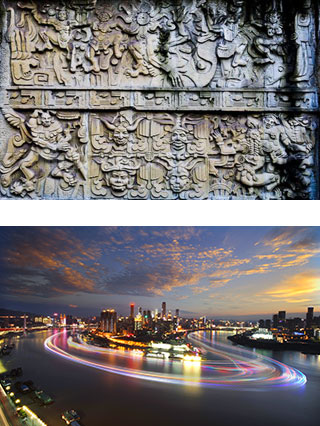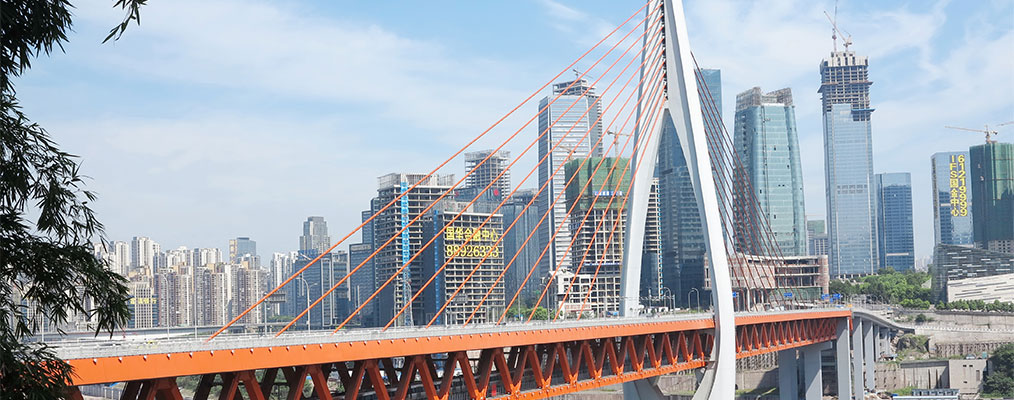
Chongqing is called Ba or Yu for short. Chongqing serves as the economic, cultural, educational and innovative center in southwestern China. Located at southwestern mainland China and the upper reach of the Yangtze River and where Jialing River and Yangtze River meet, she enjoys numerous bridges over two rivers for which she is reputed as the city of bridge. With an area of 82,400 km2, Chongqing is three times the size of Beijing, Tianjin and Shanghai, being the largest municipality. 76% of Chongqing is covered by mountains, for which she is called a city of mountains. The total population is about 33 million.
With distinct geographic advantages, Chongqing has been a key trade port along the Yangtze River since ancient times. Today, she is a new city which opens up to the outside world. With clearly-defined seasons, she is the best choice for traveling and living. At sunset, light from households shines over the surface of two rivers, reflecting stars of the sky and creating a unique night view of Chongqing. Eating hotpot, watching the beauty and tour of two rivers are three must-dos. With constant innovation, development and perfection, she will greet coming foreign visitors as she gets increasingly better.

Chongqing, located in the Southwest of China, is a well-known cultural city with a long history of over 3,000 years. Chongqing is said to be the capital city of Ba that the Ba people supposedly established during the eleventh century BC. By 316 BC, however, it had been overrun by the State of Qin. And the Qin emperor decided to construct a new city here, which was called Jiang Prefecture. Since Chongqing is surrounded by Yangzi river and Jialing river(once called “Yu river”), in 581 AD (Sui Dynasty),Yang jian, the emperor of that time, set up YuZhou here, which was the origin for Yu as the abbreviation of Chongqing today . In 1189AD, the Southern Song Dynasty government set up Chongqing Fu, which meant andsymbolized the double celebration. Up to now, the name “Chongqing” has been used for more than 800 years.
The Ming and Qing dynasties saw a period of rapid economic growth in Chongqing. Huge amounts of merchants gathered there from all over China. And in 1891, Chongqing became the first inland commerce port open to foreigners. After the outbreak of the Second Sino-Japanese War in 1937, Chongqing was Chiang Kai-shek’s provisional capital and was heavily bombed by the Japanese Air Force. Many factories and universities moved from eastern China to Chongqing during the war. Chongqing transformed from an inland port to a heavy-industrial city. After the founding of the People's Republic of China in 1949, Chongqing remained the cultural and economic center of southwestern China. In 1997 Chongqing became one of the four municipalities directly under the central government in China, and the only one in western China. Nowadays, Chongqing is faced with changes every day and she is stepping towards a brighter and more colorful future aggressively.
Historically, Chongqing has been a major trading inland port, transporting goods from the southwestern provinces to eastern China. During the Sino-Japanese War (1937-1945), Chongqing was transformed into a city with heavy industry, especially the military industry which continued to thrive for decades after 1949. Since 1980s, many of these military industry enterprises have undergone reforms and turned from producing military goods to mostly civilian products for survival and growth. Chongqing has witnessed great changes after it became the municipality directly under the central government in China in 1997. During the 21st century, the economy of Chongqing has developed rapidly.
According to the data shown in Chongqing government's economic work report from last year, Chongqing maintained steady growth in its economy, having accelerated transformation to its growth model, promoted structural adjustments and improved the quality and performance of economic growth.
In order to implement the Western Development strategy, Chinese government set up an economic zone called the West Triangle Economic Zone comprising Chengdu, Chongqing and Xi'an, which contributes nearly 40% of Western China's GDP every year. In addition, Chongqing is one of China's five National Central Cities. Besides, some large central business districts are being constructed in the centre of the city of Chongqing, such as Jiangbeizui CBD and New North Zone. These new economy zones will spur the development of the Chongqing economy and bring more opportunities.

Chongqing stands ahead of most cities in China with its abundant tourism resources. In the year of 2012, it was rated “One of top 10 tourist attractions in the world” by Frommer’s, a famous tour guide of the U.S.. At present, Chongqing enjoys some 214 tourist attractions of A level among which there are 8 AAAAA national grade scenic spots, 75 AAAA national grade scenic spots, 80 AAA national grade scenic spots. In addition, Chongqing also enjoys 2 world cultural heritage sites, namely Wulong Karst tourist attraction and Jinfo Mountain, and a natural and cultural heritage, namely Dazu Rock Carvings. Chongqing is endowed with numerous famous scenic spots and tourist attractions, such as the Three Gorges, Fengjie Tiankeng, Hechuan Fish Town, the White Crane Ridge of Fuling and so on. They all are globally well-known with prestige. In addition, Chongqing also features a large number of amusing and entertaining shopping malls, such as the foreigner street with foods all over the world and the buildings of varied styles. Chongqing has a trading port on the bank of the Jialing River that thrived during the period of Ming and Qing dynasty. Today, the trading port has become an ancient town known as Ciqikou, the symbol and miniature of ancient Chongqing or Jiangzhou. In the end, Chongqing features Jiefangbei pedestrian street offering luxuries, local featured foods and impressive shopping experience.

With rapid economic growth and constantly improved infrastructure, the traffic construction in Chongqing witnessed breakthroughs by building 16 large bridges over the Yangtze River and Jialing River. A large number of provincial and county-level highways have been completed and put into operation. The construction of railway transportation has been strengthened. For example, Chongqing-Beijing and Chongqing-Chengdu high-speed railways along with others have been put into operation; Chongqing Municipal People’s Government attached importance to the construction of the facilities at airport and improving passenger reception quality. In 2015 alone, Chongqing Jiangbei Airport witnessed a handling capacity of 32.4 million persons. In addition, Chongqing leads in information development in western China and is a modern communication network city with a large capacity and high rate predominated by optical cable. Urban development is consistently strengthened. The redevelopment of old and dangerous houses, corrections of unfinished buildings and the development of public service facilities and cultural facilities have been completed. The relaxing natural landscapes are in dialogue with the elegant modern architectures, allowing Chongqing to step into a new century in a brand new look.

Chongqing is seated at the conjunction of the Yangtze River and the Jialing River, surrounded by mountains and two rivers. The mountain city Chongqing, with a long history of over 3,000 years, has rich tourism resources. The city has splendid natural views of mountains, rivers, forests, streams, waterfalls, gorges and caves on the one hand, and rich cultural views on the other, namely, Bayu culture, ethnic culture, immigration culture, Three Gorges culture, wartime capital culture and urban culture.
Hotpot and night view are Chongqing's two features. The spicy and delicious hot pot represents not only the Chongqing cuisine, but also the vigorous and open personalities of the mountain city and its people. The night view here is the most well-known scenery in Chongqing. No matter you are standing at the viewing platform on Nanshan Mountain, walking by the riverside, or taking the Yangtze River cable-way to look down at the city, you can always appreciate the gorgeous night view of Chongqing, the “Little Hong Kong” and get a full view of the two rivers.
The enchanting sceneries of Chongqing lie in the mountains and forests and exist at streets and alleys, waiting for you to explore.